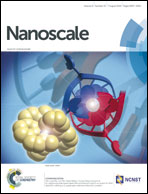All solution processed low turn-on voltage near infrared LEDs based on core–shell PbS–CdS quantum dots with inverted device structure†
Abstract
Colloidal semiconductor quantum dots (QDs) are extraordinarily appealing for the development of light emitting devices (LEDs) due to tunable and pure color emission, brightness and solution processability. This last advantage of the QD-LEDs is even more evident in the field of infrared emission where the devices currently used are prepared by high cost epitaxial techniques. Here we show the fabrication of low cost NIR QD-LEDs based on high quantum yield core–shell PbS–CdS QDs and a novel inverted device structure. Devices are produced using SnO2:F (FTO) as the conductive transparent contact, nanostructured TiO2 as the electron transport layer (ETL) and poly(3-hexylthiophene) P3HT as the hole transport layer (HTL). Despite the roughness of this ETL, the obtained external quantum efficiencies (EQEs) are similar to previously reported values, obtained with regular configuration and more expensive ITO substrates. A turn-on voltage as low as the QD band gap (1.47 eV) is achieved for a large area (1.54 cm2) and relatively stable QD-LEDs.


 Please wait while we load your content...
Please wait while we load your content...